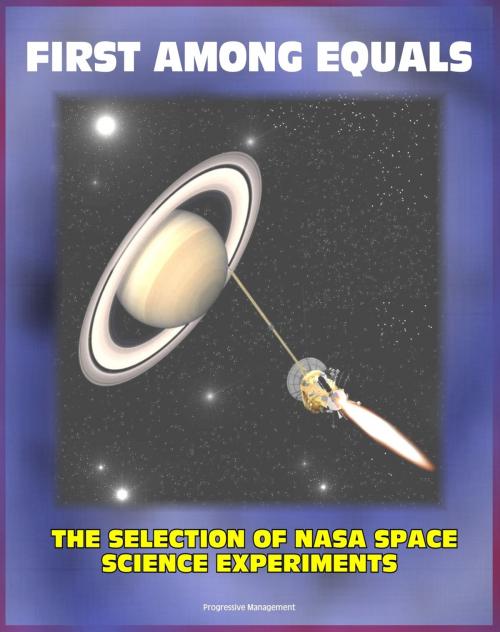First Among Equals: The Selection of NASA Space Science Experiments - Origins of NASA, Early Satellites, Webb's Influence on Science (NASA SP-4215)
Nonfiction, Science & Nature, Science, Other Sciences, Scientific Instruments, Physics, Astrophysics & Space Science| Author: | Progressive Management | ISBN: | 9781466169890 |
| Publisher: | Progressive Management | Publication: | January 18, 2012 |
| Imprint: | Smashwords Edition | Language: | English |
| Author: | Progressive Management |
| ISBN: | 9781466169890 |
| Publisher: | Progressive Management |
| Publication: | January 18, 2012 |
| Imprint: | Smashwords Edition |
| Language: | English |
This official NASA history document - converted for accurate flowing-text e-book format reproduction - describes the origin and evolution of the NASA space science selection process. Contents: The Origins of the Selection Process * The Origins of NASA * The Space Science Board * NASA Organizes * 1959: A Year of Trouble and Conflict * The NASA Process for Selecting Scientists * The Impact of James E. Webb * Summary and Assessment.
The author notes: "In this book I describe the origin and evolution of the NASA selection process. Where necessary, I touch on the concurrent political and technical forces that helped shape the process. I have not attempted to write a comprehensive history of space science. I have not attempted to describe the process that NASA uses to formulate its scientific program, nor have I attempted to critique the qualifications of the scientists selected or the value of the research they conducted. In the first five chapters, I trace the origins of space science, the Space Science Board, and NASA, and show how people, events, conflicts, forces, and decisions coalesced and led NASA to formulate its particular process in the spring of 1960. Those readers who are interested only in the details of the NASA process and the immediate circumstances surrounding its creation will find that story begins with chapter 6. I finish the story in the spring of 1962 with the NASA selection process firmly in place and the United States beginning to establish leadership in space science and technology. NASA slightly modified the selection process between 1960 and 1962 as the leaders of the agency and space scientists gained experience. In the spring of 1961, James E. Webb became the NASA administrator. In November 1961, he reorganized the agency, created the Office of Space Science at NASA Headquarters, and placed a scientist, Dr. Homer E. Newell, in charge of NASA's space science program. Today, the NASA space science organization is much the same as the one Newell created in late 1961."
In the fall of 1957, with the launch of Sputnik I, scientists began to explore a new universe outside the Earth's atmosphere, a universe previously invisible to astronomers and beyond the reach of physicists. Scientists and the media promptly nicknamed this universe "space" and began to call the people who explored it "space scientists." In the spring of 1958, the United States created the National Aeronautics and Space Administration (NASA) and directed it to maintain U.S. leadership in space science and technology. At the same time, the National Academy of Sciences created a Space Science Board to interest scientists in space research and to advise NASA and the other federal agencies the Academy expected to be engaged in space research. As scientists recognized the potential for major scientific discoveries in space, they began to fight for the limited opportunities to place their instruments on board NASA spacecraft. As a result of this intense competition, a quiet but equally intense struggle developed between NASA Headquarters and the Space Science Board. Each wanted to control the process to select space scientists. Inside NASA, a similar struggle evolved between NASA Headquarters and the Jet Propulsion Laboratory. It took NASA three hectic years to hammer out a selection process that was acceptable to the scientists, administrators, lawyers, procurement specialists, and the institutions involved. Three decades later, NASA continues to use that same basic process: the associate administrator for the NASA Office of Space Science and Applications selects the space scientists for all NASA's missions. It is not a trivial responsibility. A major space science mission, such as Viking or the Space Telescope, may involve 100 scientists, require twenty years to complete, and cost more than a billion dollars.
This official NASA history document - converted for accurate flowing-text e-book format reproduction - describes the origin and evolution of the NASA space science selection process. Contents: The Origins of the Selection Process * The Origins of NASA * The Space Science Board * NASA Organizes * 1959: A Year of Trouble and Conflict * The NASA Process for Selecting Scientists * The Impact of James E. Webb * Summary and Assessment.
The author notes: "In this book I describe the origin and evolution of the NASA selection process. Where necessary, I touch on the concurrent political and technical forces that helped shape the process. I have not attempted to write a comprehensive history of space science. I have not attempted to describe the process that NASA uses to formulate its scientific program, nor have I attempted to critique the qualifications of the scientists selected or the value of the research they conducted. In the first five chapters, I trace the origins of space science, the Space Science Board, and NASA, and show how people, events, conflicts, forces, and decisions coalesced and led NASA to formulate its particular process in the spring of 1960. Those readers who are interested only in the details of the NASA process and the immediate circumstances surrounding its creation will find that story begins with chapter 6. I finish the story in the spring of 1962 with the NASA selection process firmly in place and the United States beginning to establish leadership in space science and technology. NASA slightly modified the selection process between 1960 and 1962 as the leaders of the agency and space scientists gained experience. In the spring of 1961, James E. Webb became the NASA administrator. In November 1961, he reorganized the agency, created the Office of Space Science at NASA Headquarters, and placed a scientist, Dr. Homer E. Newell, in charge of NASA's space science program. Today, the NASA space science organization is much the same as the one Newell created in late 1961."
In the fall of 1957, with the launch of Sputnik I, scientists began to explore a new universe outside the Earth's atmosphere, a universe previously invisible to astronomers and beyond the reach of physicists. Scientists and the media promptly nicknamed this universe "space" and began to call the people who explored it "space scientists." In the spring of 1958, the United States created the National Aeronautics and Space Administration (NASA) and directed it to maintain U.S. leadership in space science and technology. At the same time, the National Academy of Sciences created a Space Science Board to interest scientists in space research and to advise NASA and the other federal agencies the Academy expected to be engaged in space research. As scientists recognized the potential for major scientific discoveries in space, they began to fight for the limited opportunities to place their instruments on board NASA spacecraft. As a result of this intense competition, a quiet but equally intense struggle developed between NASA Headquarters and the Space Science Board. Each wanted to control the process to select space scientists. Inside NASA, a similar struggle evolved between NASA Headquarters and the Jet Propulsion Laboratory. It took NASA three hectic years to hammer out a selection process that was acceptable to the scientists, administrators, lawyers, procurement specialists, and the institutions involved. Three decades later, NASA continues to use that same basic process: the associate administrator for the NASA Office of Space Science and Applications selects the space scientists for all NASA's missions. It is not a trivial responsibility. A major space science mission, such as Viking or the Space Telescope, may involve 100 scientists, require twenty years to complete, and cost more than a billion dollars.















